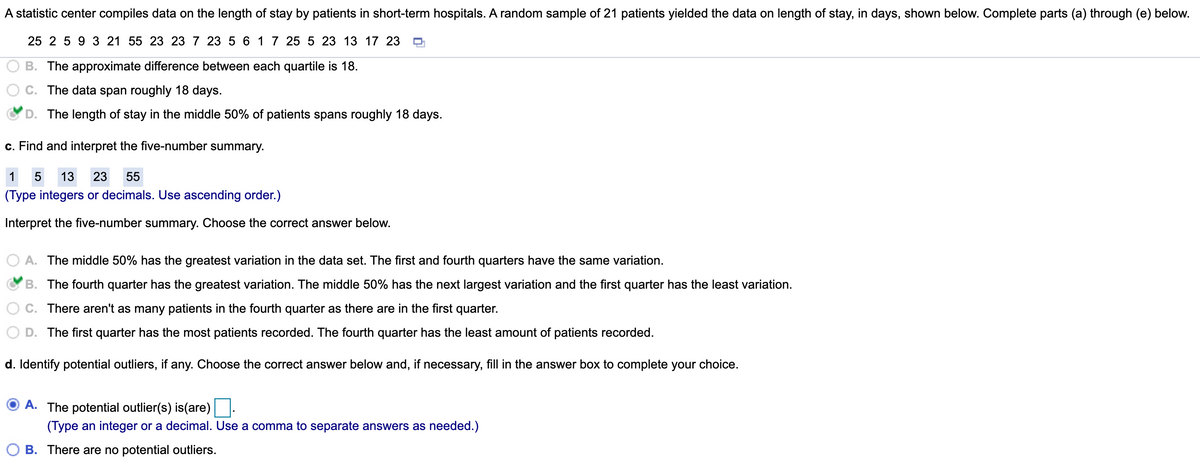A statistic center compiles data on the length of stay by patients in short-term hospitals. A random sample of 21 patients yielded the data on length of stay, in days, shown below. Complete parts (a) through (e) below. 25 2 5 9 3 21 55 23 23 7 23 5 6 1 7 25 5 23 13 17 23 - O B. The approximate difference between each quartile is 18. O C. The data span roughly 18 days. YD. The length of stay in the middle 50% of patients spans roughly 18 days. c. Find and interpret the five-number summary. 1 5 13 23 55 (Type integers or decimals. Use ascending order.) Interpret the five-number summary. Choose the correct answer below. O A. The middle 50% has the greatest variation in the data set. The first and fourth quarters have the same variation. B. The fourth quarter has the greatest variation. The middle 50% has the next largest variation and the first quarter has the least variation. O C. There aren't as many patients in the fourth quarter as there are in the first quarter. O D. The first quarter has the most patients recorded. The fourth quarter has the least amount of patients recorded. d. Identify potential outliers, if any. Choose the correct answer below and, if necessary, fill in the answer box to complete your choice. O A. The potential outlier(s) is(are)- (Type an integer or a decimal. Use a comma to separate answers as needed.) O B. There are no potential outliers.
A statistic center compiles data on the length of stay by patients in short-term hospitals. A random sample of 21 patients yielded the data on length of stay, in days, shown below. Complete parts (a) through (e) below. 25 2 5 9 3 21 55 23 23 7 23 5 6 1 7 25 5 23 13 17 23 - O B. The approximate difference between each quartile is 18. O C. The data span roughly 18 days. YD. The length of stay in the middle 50% of patients spans roughly 18 days. c. Find and interpret the five-number summary. 1 5 13 23 55 (Type integers or decimals. Use ascending order.) Interpret the five-number summary. Choose the correct answer below. O A. The middle 50% has the greatest variation in the data set. The first and fourth quarters have the same variation. B. The fourth quarter has the greatest variation. The middle 50% has the next largest variation and the first quarter has the least variation. O C. There aren't as many patients in the fourth quarter as there are in the first quarter. O D. The first quarter has the most patients recorded. The fourth quarter has the least amount of patients recorded. d. Identify potential outliers, if any. Choose the correct answer below and, if necessary, fill in the answer box to complete your choice. O A. The potential outlier(s) is(are)- (Type an integer or a decimal. Use a comma to separate answers as needed.) O B. There are no potential outliers.
Glencoe Algebra 1, Student Edition, 9780079039897, 0079039898, 2018
18th Edition
ISBN:9780079039897
Author:Carter
Publisher:Carter
Chapter10: Statistics
Section10.3: Measures Of Spread
Problem 1GP
Related questions
Question
Part d

Transcribed Image Text:A statistic center compiles data on the length of stay by patients in short-term hospitals. A random sample of 21 patients yielded the data on length of stay, in days, shown below. Complete parts (a) through (e) below.
25 2 5 9 3 21 55 23 23 7 23 5 6 17 25 5 23 13 17 23
B. The approximate difference between each quartile is 18.
C. The data span roughly 18 days.
D. The length of stay in the middle 50% of patients spans roughly 18 days.
c. Find and interpret the five-number summary.
1
13
23
55
(Type integers or decimals. Use ascending order.)
Interpret the five-number summary. Choose
correct answer below.
A. The middle 50% has the greatest variation in the data set. The first and fourth quarters have the same variation.
B. The fourth quarter has the greatest variation. The middle 50% has the next largest variation and the first quarter has the least variation.
C. There aren't as many patients in the fourth quarter as there are in the first quarter.
D. The first quarter has the most patients recorded. The fourth quarter has the least amount of patients recorded.
d. Identify potential outliers, if any. Choose the correct answer below and, if necessary, fill in the answer box to complete your choice.
A. The potential outlier(s) is(are)
(Type an integer or a decimal. Use a comma to separate answers as needed.)
B. There are no potential outliers.
Expert Solution
This question has been solved!
Explore an expertly crafted, step-by-step solution for a thorough understanding of key concepts.
This is a popular solution!
Trending now
This is a popular solution!
Step by step
Solved in 2 steps

Knowledge Booster
Learn more about
Need a deep-dive on the concept behind this application? Look no further. Learn more about this topic, statistics and related others by exploring similar questions and additional content below.Recommended textbooks for you

Glencoe Algebra 1, Student Edition, 9780079039897…
Algebra
ISBN:
9780079039897
Author:
Carter
Publisher:
McGraw Hill

Glencoe Algebra 1, Student Edition, 9780079039897…
Algebra
ISBN:
9780079039897
Author:
Carter
Publisher:
McGraw Hill